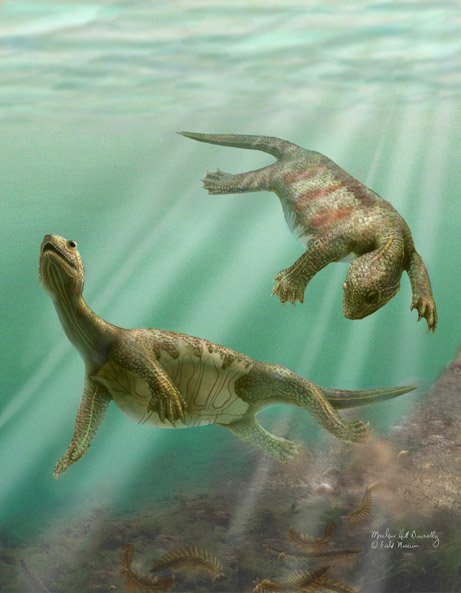National Geographic News:Oldest Turtle Found; May Crack Shell-Evolution Mystery

The 220-million-year-old animals did not have full shells, or carapaces, on their backs, researchers found.
But the newfound creatures did sport fully developed plastrons—the flat part of a turtle shell that covers and protects the belly.
The discovery supports the theory that turtle shells formed from the underside—plastron first—and grew bony extensions of ribs and backbones that eventually joined to form the classic shell that exists today.
(Related: "Earliest Swimming Turtle Fossils Found—New Species" [November 19, 2008].)
Alternate Theory
An alternate theory of shell evolution suggests that turtle shells developed from the fusion of bony armor plates in the skin, known as osteoderms, seen in some dinosaurs and some modern-day reptiles, including crocodiles.
But the prehistoric turtle, dubbed Odontochelys semitestacea and described in a recent edition of the journal Nature, has no osteoderms.
"So far there is no direct evidence for the osteoderm theory," said study co-author Chun Li of the Institute of Vertebrate Paleontology and Paleoanthropology at the Chinese Academy of Sciences in Beijing.
"On the contrary, here, in our hands, there is an ideal missing link for turtle evolution. It has no osteoderms on its back, but only ossified neural [central] plates and expanded ribs."
(Explore a prehistoric time line.)
The study also notes that embryonic evidence from modern turtles suggests that their shells begin to form in a similar manner.
"If plastrons developed first, they may point to a marine lifestyle in which turtle bellies needed protection from predators," Li noted.
"We are not sure if the water [was] marine or [from other water bodies], so we presumed … that the animal inhabited marginal areas of the sea or deltas," he said.
Exciting Discovery
Scientists have waited a long time for a find like Odontochelys, Li said: The previously oldest known turtles featured fully formed shells.
"The new specimens are a very exciting discovery," agreed Robert Reisz of the University of Toronto, who was not involved in the research.
But Reisz suggests an alternate evolutionary interpretation for the intriguing fossils.
"Their argument is valid," he said of Li and colleagues.
"But we argue that it`s equally possible that this could already be a [shell] reduction in an earlier turtle that we haven`t found. Lots of marine turtles actually reduce their shell once they get into the water."
"Hopefully we`ll find more," Reisz added. "We`re closing the gap, but there is still a big morphological gap between this turtle and its non-turtle ancestors."
Odontochelys also boasts another feature seen in no other turtles so far—teeth, Reisz added.
"Basically if you look at all the turtles we know, other than this one, they all have a beak rather than teeth," he said.
"Turtles come from reptile ancestors with teeth so we expected this, but it`s still a great thing to find."
Download attachments: